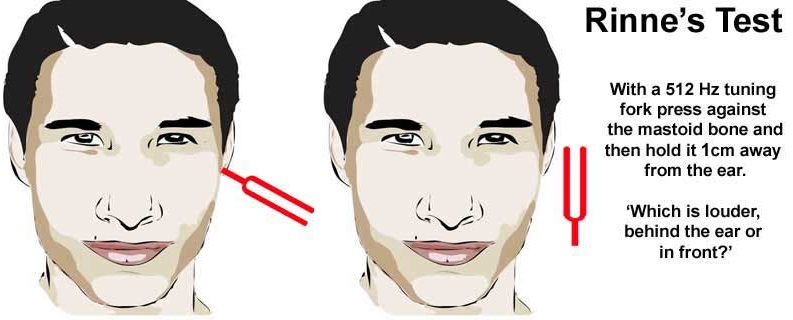44++ Rinne And Weber Test Explained
Rinne And Weber Test Explained. As with other hearing tests, it helps people quickly identify hearing loss. Depends on a practical understanding of the anatomy of the ear, a suitable choice of otoscope and speculum, and a reliable examination technique.

Normally, the sound is heard equally in both ears. This means that there is either a conductive deafness in the right ear or a sensory deafness in the left ear. Due to the sound localization process, in a patient with a unilateral conductive hearing loss, the sound will be.
prise electrique italie quelque note damour prix prix big bag sable point p robot gardena
Tuning fork test
What does the rinne test do? The inner ear mediates sensorineural hearing. In the weber test, the base of a gently vibrating tuning fork is placed on the midforehead or the vertex. This means that there is either a conductive deafness in the right ear or a sensory deafness in the left ear.

There are different causes of sens. The patient is asked which ear hears the sound better. Why spend 3 hours stuck in a textbook when you could understand this high yield topic in 3 minutes!have a look at the latest video on ascending spinal cord w. It can serve as a quick screen for conductive hearing loss. They help determine.

Now, these are a couple of tests involving the use of a tuning fork that can be used to supplement your examination. Each test uses a similar tool but different methods to complete the test. Determination of a conductive vs. They help determine whether you may have conductive or. Ask if the tone is louder in the left ear, the.

The weber test is a useful, quick, and simple screening test for evaluating hearing loss. Thus, one can quickly suspect conductive hearing loss. The rinne test is a specific kind of hearing test. Tap a 512hz tuning fork and place in the midline of the forehead. Over the years, many types of tuning forks tests had been developed to assess.

The weber test is often combined with the rinne test to detect the location and nature of the hearing loss. Equipment choosing an otoscope a suitable otoscope with a pneumatic attachment is essential for reliable and accurate otological examination (figure 1). Ask if the tone is louder in the left ear, the right ear or equally loud in both ears..

A rinne test should be done in conjunction with a weber test to detect sensorineural hearing loss. Children with mixed, or bilateral hearing loss, should be referred to an ent specialist for a more formal pure tone. This means that there is either a conductive deafness in the right ear or a sensory deafness in the left ear. Weber lateralizes.

We will guide you through everything you need to know about the rinne test procedure and results. Weber and rinne tests are reliable and useful tools for assessing hearing loss in older, verbal children. Over the years, many types of tuning forks tests had been developed to assess hearing loss, but today only two have withstood the test of time:.

Rinne and weber hearing tests are two methods for examining hearing loss in an individual. Equipment choosing an otoscope a suitable otoscope with a pneumatic attachment is essential for reliable and accurate otological examination (figure 1). Why spend 3 hours stuck in a textbook when you could understand this high yield topic in 3 minutes!have a look at the latest.

The rinne test is a specific kind of hearing test. It is essential that the otoscope is The patient is asked which ear hears the sound better. In this short post, we're going to have a look at the rinne and weber tests. They complement one another by both testing for unilateral hearing loss.